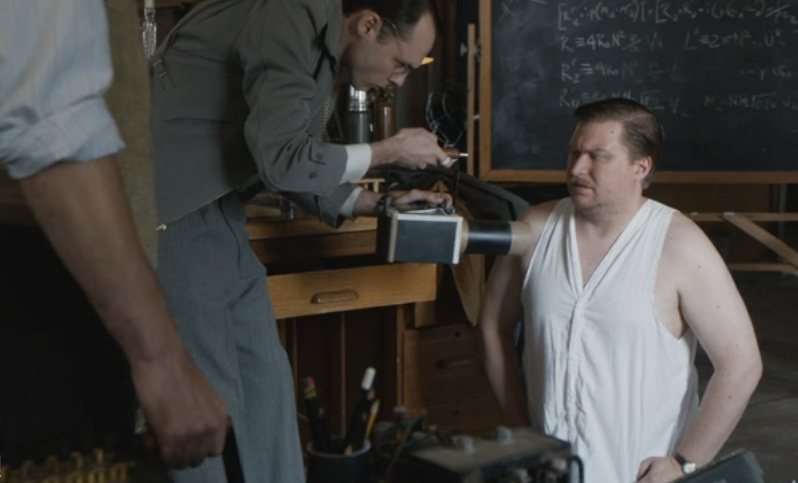The sixth installment of the Manhattan series begins by underscoring the driving force behind the Manhattan Project: the race to beat Nazi Germany to build an atomic bomb. The episode’s opening scene features a villainous looking Werner Heisenberg (the Director of the German atomic program) walking into a laboratory filled with scientists and armed Nazi guards. The sign on the door: “Zyklotron.”
Despite an introductory glimpse at the German laboratory, Manhattan’s sixth episode focuses on the exposure to highly radioactive materials and how the project dealt with protecting worker health and safety.
At Los Alamos, physicist Frank Winter is racing against the clock to produce some “real data” on the miniscule amount of plutonium the lab has received. As the lead plutonium chemist, Fritz Fedowitz must perform the analysis but his obsession over one of the enlisted women has taken his mind…elsewhere. An exhausted Fritz accidently opens the plutonium sample to the air, vaporizing nearly a million dollar’s worth of plutonium and exposing himself to a plutonium-filled vapor.
Returning to the lab, Jim Meeks and Paul Crosley find a frantic Fritz searching the floor in hopes of recovering a few micrograms of the lost plutonium. A Geiger counter zeros in on Fritz’s throat: most of the plutonium appears to be inside the chemist. Dr. Alderman, the site’s medic and ‘radiation expert’ pumps his stomach in order to recover the plutonium and prescribes a case of beer to flush out the rest.
The incident is closely patterned after one that actually happened to plutonium chemist Don Mastick at Los Alamos on August 4, 1944. In this case, liquid plutonium in a vial had undergone an unanticipated transformation overnight. Just like the incident in Manhattan, some of the liquid became a gas and was ingested by Mastick.
At the time, the medical doctor at Los Alamos was Louis Hempelmann. He was only twenty-nine and like Manhattan’s Dr. Alderman, he had little understanding of radiation’s effects on the human body. After hearing Mastick’s account, Hempelmann made a frantic call to Stafford Warren, the medical director of the Manhattan Project. An Army colonel who worked at the project’s administrative headquarters in Oak Ridge, TN, Warren was responsible for conducting research on the health effects of radiation exposure and reported directly to General Groves.
According to Eileen Welsome’s account in “The Plutonium Files” (The Dial Press, 1999), Warren told Hempelmann to use a mouthwash, expectorant and stomach pump to remove the plutonium. Like the Manhattan account, the doctor handed the patient a four-liter beaker of murky liquid. As the plutonium chemist, Mastick was responsible for retrieving the plutonium from his own fluids.
In the TV show and some real Manhattan Project incidents, the ingestion of plutonium did not cause adverse health effects. Manhattan Project chemist Lawrence Bartell had a similar experience while performing an experiment with plutonium at the University of Chicago. “One of the things that we had to do was to pipette solutions to get the right amount to mix and to precipitate,” recalls Bartell, and “one day the pipette backed up and I found myself with plutonium in my mouth.”
Bartell, who was embarrassed by his mistake and was too ashamed to go to the health physics division, rinsed out his mouth as best he could and went about his day. According to Bartell, plutonium “goes through the body fairly fast if taken orally.” If it gets into your lungs, however, “you’re in very bad trouble.”
Manhattan makes clear that the Army is more concerned about secrecy and deadlines than worker safety or the environment. Sent to inspect the operations at Oak Ridge, Charlie Isaacs and Helen Prins were assigned fake identities (“Mr. and Mrs. Donaldson”) and tasked with inspecting the X-10 Graphite Reactor before it goes critical. When Charlie begins questioning the plant’s directors about reactor safety measures and evacuation protocol, they are quick to dismiss his concerns: “Safety is a priority, but the Army’s deadline is a Gospel around here.”
Back at Los Alamos, Lisa Winters is convinced that the Army’s use of DDT and other pesticides is responsible for the death of the bees that she is propagating in a beehive. Lisa confronts one of the guards at Los Alamos about DDT which she explains can cause insects to have seizures, internal bleeding and organ failure. The guard’s response: “Good thing we’re not mosquitos, right?”
Perhaps the most startling discovery occurs when Frank realizes that the entire radiation monitoring program at Los Alamos is a charade. The program is orchestrated by one of Los Alamos’ highest ranking scientists, Alek Barath. Frank confronts him with disbelief and outrage. Barath once worked in Marie Curie’s lab and certainly should know the potential health effects of radiation exposure. Curie, who did not know the effects of radiation when she began her studies, died of leukemia in 1934. More than a century later, much of Curie’s belongings—her papers, her furniture, even her cookbooks—are still radioactive.
Just when it seems Frank’s problems can’t get any worse, Col. Aden Cox hands him a report from a well-placed German intelligence agent. The agent, codenamed “Magpie,” has obtained equations and calculations that indicate that Werner Heisenberg’s program is two months ahead of the Manhattan Project. After glancing at the calculations, Frank believes the Germans are getting ready to test their own atomic bomb.
For now, viewers will have to wait and see!





